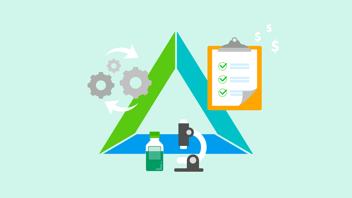The Babraham Institute is a fundamental life sciences research institute based on the Babraham research campus, situated six miles southeast of Cambridge University for whom the institute is a recognized university partner institution. The institute has been in continuous operation for more than 70 years, beginning life in 1948 as the Institute of Animal Physiology before its mission evolved to be an international leader in basic cell and molecular biology with an emphasis on healthy aging and maintaining health throughout life.
The institute receives strategic funding from the Biotechnology and Biological Sciences Research Council, which supports its three core areas of research, immunology epigenetics, and cell signaling. Alongside its internationally recognized research, the institute maintains unique scientific facilities of national importance, which are also available to the 60+ biotechs located on the research campus.
All these labs, research, and scientists require a steady flow of supplies, which is primarily overseen by the institute’s Stores and Purchasing team. Led by our guest, Michael Norden, the team manages supplier relationships to ensure availability and best price for the equipment and consumables they subsequently purchase and distribute to researchers, staff, and students for their world-class science.
...the (Babraham) institute maintains unique scientific facilities of national importance, which are also available to the 60+ biotechs located on the research campus...the institute’s Stores and Purchasing team...manages supplier relationships to ensure availability and best price for the equipment and consumables...
Michael, welcome to the podcast.
Thanks, Greg. It's a pleasure to be here.
Now you have the distinction of being one of ZAGENO’s longest, continuous customers and, when we talked in a previous conversation, you had shared a little bit about that first interaction. Can you bring us back to that time when you learned about ZAGENO and eventually decided to become a member of this community?
Yeah, I'll start off going back to 2012. We left a research council shared service center, which used to be responsible for all of our purchasing - so it's all done in a centralized area in Swindon (UK). But when we left that arrangement, it meant that we lost access to Science Warehouse, which was the purchasing platform that went with the arrangement. And so for the years after that, we come up with a fairly unsatisfactory solution, which meant that for our researchers to source products or to find our discounted pricing, they had to log into each individual supplier’s website or they had to trawl through Excel price files, which we had on our intranet, which as you can imagine, wasted a huge amount of our researcher’s time, just trying to find the correct products. And then even once they’d done that they then had a lot of manual keying to actually put in the requests for the order.
So, all in all, it was incredibly time-consuming. And we had approached several of the main players in the purchasing platform business and we couldn't find one that solved all the issues we had and integrated properly with our ordering system.
And it was quite fortunate how the introduction to ZAGENO actually came about.
I think there was a presentation at the moment of new startups and the CEO of the Babraham Research Campus happened to be one of the people present there that his presentation. And at the end of it, he approached the ZAGENO representative and said, although what you're offering isn't relevant to me, I think it would be well worth your while talking to Michael in purchasing, on the campus. So, the CEO came along, gave me the contact details of a guy called Kilian at ZAGENO. So, I've made the initial call and we set up a meeting - I think it was towards the end of 2016.
And so the problem you were trying to solve was largely based on the administrative burdens that you had experienced to that point. How long had you suffered through Excel spreadsheets and having to do a lot of manual cross-referencing to make sure that products were what people intended them to be (and) needed them to be?
We'd been struggling through for about four years. And it was one of those situations where, if anything, people got more frustrated than longer it went on.
Although we tried to find different tweaks and try to make it, as usable as possible with the restrictions we had, it was very difficult, very unsatisfactory. And ultimately even if people spent quite a lot of time trying to source the correct product from the right supplier you couldn't always guarantee they got (the) best value for that product unless we got bogged down in a huge amount of double-checking. So, we'd pretty much got to the end of our tether both myself and our purchasing team, and more importantly, our researchers who were just like why are we wasting so much of our working time just trawling through websites and files. It’s not what we’re here to do.
We'd been struggling through for about four years....we'd pretty much got to the end of our tether both myself and our purchasing team, and more importantly, our researchers who were just like why are we wasting so much of our working time just trawling through websites and files. It’s not what we’re here to do.
You're unlike a lot of procurement leaders who tend to work within one organization; maybe they're supporting several teams, different projects, perhaps, but I'm curious what a day in the life of Michael Norden is.
Yeah. Interesting question. So the setup is slightly unusual. So, although I'm an active employee of the Babraham Institute and manage the campus central purchasing of the store's facility, as you say we offer that service to everyone who's on the campus. So, there's the Babraham Institute staff, then the 60+ biotechs.
From there, you can imagine the amount of different demands for different purchasing requirements from both the sort of academic side of things and the commercial side of things. And it's really a case -a large part of my time is taken up responding to those requests because every one of those biotechs has their own kind of unique issues or requirements.
Similarly, with the different labs within the institute - each lab within the institute is semi-autonomous, as well. And so it's a wide variety of assistance in sourcing products, negotiating products, particularly with the present supply chain issues, just trying to find alternative products.
If someone says, historically, we've always used this particular brand - can you get hold of it and what would the price be...what kind of timescale are we talking about for delivery? And so that's very much a large part of my standard day at the moment. And then on top of that, we're finding more and more, although we have pricing agreements in place with most of our core suppliers, because of the supply chain issues policies are changing all the time.
Some products particularly say nitrile gloves, as an example, they've gone up 400% in the space of about nine months. And when it's such a core, fundamental product...I mean you can't work in the labs without nitrile gloves...it's not a thing that you think well we won’t bother...you still have to get them but it’s A) trying to source them and also trying to source them at a realistic price because everyone has their own fixed, internal budgets. And no one's factored in that suddenly these things are going to go 400%.
Wow. That's incredible.
You talked about something else when we talked a few weeks ago about tissue culture, plasticware, where and a particular loyalty that some of the teams you support have for certain brands. Can you share again what occurred?
Yeah, I think they're a really interesting example because probably more than any other lab consumable researchers tend to have the greatest loyalty to a particular brand of tissue culture plasticware.
It’s primarily, in research, you always want consistency of results. And the different brands of tissue culture plasticware can have different adhesive qualities to them which will then lead to different results at the end of an experiment. So, historically, if someone's always used, say Nunc plasticware for their tissue culture work, they’ll always stick with Nunc so that they know if there's any difference in the end result, it won't be because of the plasticware.
And so, year on year, despite whatever may happen to pricing, people will always stick with a particular one. We'll have reps come in, offering all-new, exciting brands of tissue culture plasticware and people won't even try and trial them either...I’m just happy with what I’m using.
...what we've found in the last 20 months (is) it's just become impossible to stick to a particular brand because all of the main players, at some point, experience supply issues.
But what we've found in the last 20 months (is) it's just become impossible to stick to a particular brand because all of the main players, at some point, experience supply issues. And it's not a case of well, you can hang on for a couple of weeks and we’ll get that van back in. More and more often it's three months time and we may get some and the fact that even then they can't be categoric, (that) you will get them three months. It’s like we're hoping there may be some availability but it might be four months, may be five months. And from a lab point of view, you just can't work on that kind of basis. And so ultimately they've had to be pragmatic, okay, what brands are available? And so they've had to compromise, take the brands that we happen to have at that time, and get on with them.
And one of the most interesting things is I thought I was going to get a flurry of adverse comments and people just very unhappy with the products or the results they were getting. But up until this point I've had no negative feedback (from) people having to use an alternative brand they've not previously used, which has been quite an eye-opener.
Yeah, it was fascinating to me, because those of us that are in the business of science but are not ourselves, scientists have come to understand scientists have their reasons for loyalty. But in this case, when push came to shove, as it were, they chose availability over that brand loyalty.
And it leads me to ask, as supply problems start to ease, you have an idea as to what the teams you support will feel about those older products or that newer products will continue to be used because they've been effective.
Yeah, I think this is going to be one of the really interesting things to see how it does pan out. If I was some of the larger brands, I would be quite concerned about how much market share they're going to lose in the long term. Because, as I've already said, the fact that certainly from the feedback I've had people seem to be happy with the alternative brands. And some of those brands are quite new players in the market.
And if you went back two years ago, people wouldn't have even bothered sampling them, let alone actually using them in experiments. And so moving forward to more normal times, I generally don't know. Certainly more established researchers or possibly being here for 20 years or so may thus go back to what they always knew and always felt comfortable with.
But I feel, particularly with researchers that are probably newer to the lab, and certainly, some of the kind of startups on our campus and much more open-minded and will probably be more flexible. I think when actually you've been using product X, it's been completely satisfactory, we're happy with the quality and the price. Why don't we stick with it?
...I think it's an opportunity for the suppliers and manufacturers that have smaller brands to actually get in early and follow up with the researchers who are using their products...
And I think it's an opportunity for the suppliers and manufacturers that have smaller brands to actually get in early and follow up with the researchers who are using their products to check with them. Is there anything that could be done to either improve the product further? Or could they tweak the pricing a bit to encourage them to stick with them? You tend to find those smaller companies are much more nimble and flexible to actually respond to that kind of immediate feedback than some of the larger brands where everything is quite set and it's very difficult for them to change overnight.
You've touched on an interesting point, and it puts me in mind of the idea that the newer scientists - certainly those that are below the age of 40 - grew up in the internet age.
And it's quite common for them to be digital consumers from the moment they became consumers. Whereas those that are 50+ recognize a more tactile purchasing experience but the digital experience, as well. But speaking to that younger group that you referred to as maybe being a little bit more accepting of the brands that are available so long as they're performing well, do you feel that they feel the same way about the buying experience being online is to them something they're more accustomed to, more comfortable with. It's more organic for them?
Absolutely. I think, partly, as you said, that being brought up with that experience since they were kids. Whereas perhaps for older researchers it's not the most natural thing. I'm so old that if you go back to when I first started, we still had a Rolodex of cards with all the supplier details, handwritten on cards. We still printed off our purchase orders and put them in the post, to our suppliers.
And you look back and you think what it's so old fashioned and not that long ago, but that was the experience where, for our researchers, they would literally fill in a paper chit and come to the purchasing office and hand over and say, can you buy this for me? And, that would be the extent of what they did. Just log onto a computer and all the information's there at your fingertips and particularly the same with a purchasing platform like ZAGENO, the fact that if it's fairly generic products that it would bring up all of our previous suppliers who supply that product and then list it in price order, as well. So all that work is done. Then the information, once they've created a basket, defaults directly into our purchasing system. They hadn't even got to manually key all of that information. It's just a painless experience, but it matches their everyday purchasing in their personal lives, as well.
Do I still have any of those old Sigma red books lying around?
You remember those, do you? I remember we used to dread the time when we would get pallets of them delivered. And you just think of the sheer cost and waste of resources on these huge catalogs. We used to get so many at a time and then have to go around the labs, dropping them off everywhere. And it just seems so bizarre relatively recently that was the norm. And then pretty much as soon as it was published it was already obsolete and out of date because new products come along, prices have changed, you name it.
It's funny because I actually had a conversation about this with some of my team and they looked at me as if I was an absolute dinosaur in saying some of the ways we operated and what went on.
Well, going back to that earlier point of a democratization in the industry, where there's those loyal brands we want to see thrive and available, and newer brands that offer people choice.
What advice do you have for those organizations that might be seeing an opportunity to retain production for some of these new customers that they have won because of availability, backorders, and lead times?
Certain areas of the (Babraham) research park had almost been a closed shop. When you look, there will be three or four huge brands, which probably account for 90-95% of the turnover of that particular product. And I think the fact that some of these smaller brands and suppliers have now had this opportunity to get their foot in the door, which was previously denied to them, is a huge opportunity for them to explore. And it's one of those ones where they do have to think quite carefully about how do they best go about it. But I definitely feel it starts by going through people like myself who can actually identify who are the individuals who are buying your product.
...these smaller brands and suppliers have now had this opportunity to get their foot in the door, which was previously denied to them, is a huge opportunity for them to explore.
And then get them into a conversation with the people who are currently using it, just to gauge what their thoughts aren't moving forward about whether they would stick with them or how loyal they will be to the previous brands and really have that kind of ongoing discussion with them. Because I think it'd be dangerous think well, okay we've now got a foot in the door, we have X amount of business and things that would just carry on. So, they’re all going to have to work quite hard to A) maintain the market share they've got, but then also to try and expose it further, it might be pushing wider as well.
Interesting. This has been a fascinating conversation and we've touched on a lot of interesting things. I'm envisioning the pallet of catalogs arriving and the sort of the headache of having to get these around the campus and into the hands of the scientists,
But then of course there was that time when you met Kilian and became an early adopter of a nascent idea, back in 2016. It's five years on from that and things have obviously changed within ZAGENO. It leads me to ask what you think is next - do you have any ideas of what we need to deliver on in the coming years?
Well, That's a big question. Yeah. I'm a firm believer in whatever solution we have has to be one that works for our researches because sometimes it's fairly easy for people like me to look at it from a purely, procurement point of view and sometimes forget if the people who ultimately ones who want the products aren’t happy with the solution we've got then and we haven't really got a solution.
So, I think whatever developments come in, it's always got to be an eye on how will this run with the researchers? Would it make their lives easier? Would it be easy to find the products they bought and how flexible it would be? Because of the nature of research, it's never static so you got to have a system that is flexible and can reflect any changes that are going on. One of the things I’ve liked, when we joined you so early, that certain changes within your platform came about through conversations with myself and some of our researchers who were the original ones trialing for the institute.
One of the things I’ve liked, when we joined you so early, that certain changes within your platform came about through conversations with myself and some of our researchers who were the original ones trialing for the institute.
And I think that's going to be an ongoing thing where the conversations with researchers about well, okay, how can the platform be better to how can it better reflect your requirements?
Because ultimately if the researchers don’t want to use it, then it's a waste of everyone's time and effort.
Yeah, long may that collaboration continue.
I think in any software business, it's made better by feedback that's taken seriously, that's put into a roadmap, and is made part of the future of the customer experience.
Michael Norden, it's been a pleasure talking with you, today. I've learned so much about your experience, the responsibility that you have to so many teams, such a complex arrangement that happens there, but clearly, you've made some really interesting decisions on behalf of all those teams.
We're grateful to have you as a customer and look forward to many years of success. Thank you again.
Thanks, Greg. It's been fun.




